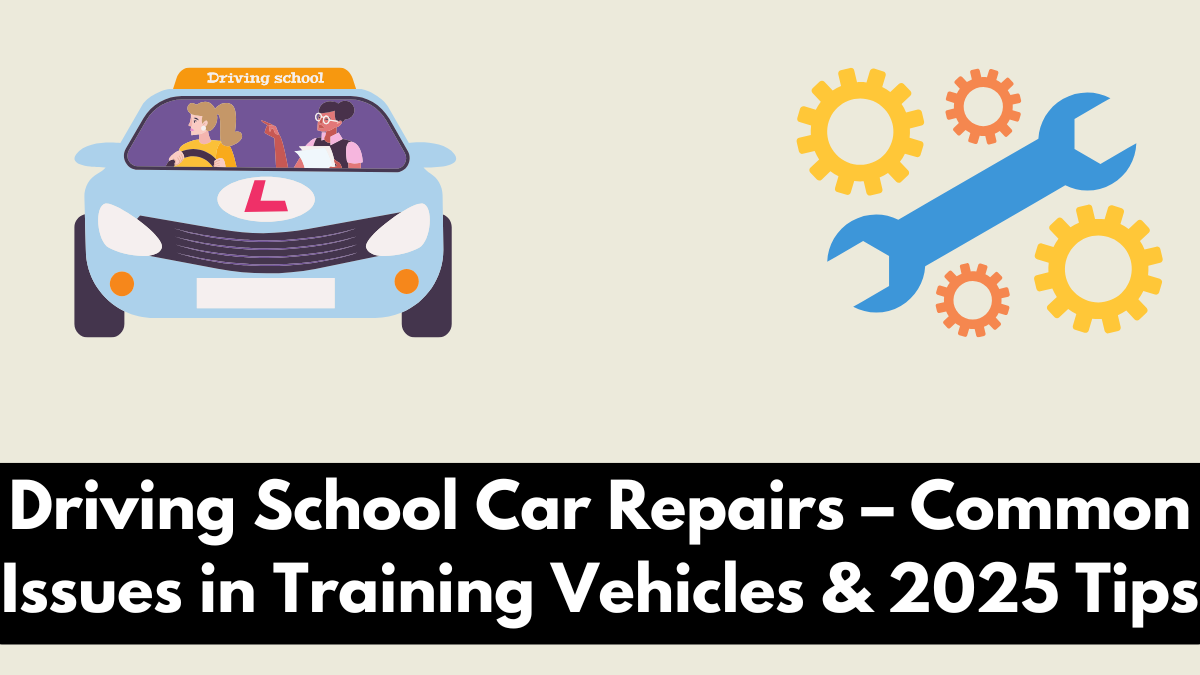Driving school vehicles endure more wear and tear than any regular car on the road. With beginners constantly using the clutch, brakes, and gears, Driving School Car Damage becomes inevitable. In 2025, as more people enroll in driving lessons, the maintenance burden on training vehicles continues to rise.
Unlike personal vehicles, these cars are used daily for multiple hours under heavy strain. Without timely checks, damage builds up, impacting not just performance but also safety. This makes Training Vehicle Maintenance Tips all the more crucial for instructors and vehicle owners who want to reduce repair costs and increase uptime.

Common Problems in Driving School Cars
From sudden braking to over-revving engines, the way learners drive leads to several mechanical and electrical issues. Identifying these early can prevent major breakdowns.
Typical Driving School Car Damage includes:
-
Premature clutch wear due to frequent half-clutch driving
-
Overheating of brakes from sudden and repeated stops
-
Misalignment of tyres and steering from hitting potholes or curbs
-
Starter motor damage from excessive restarts
-
Gearbox strain due to improper shifting
-
Electrical issues from accessory overuse or improper handling
These problems require regular inspection, making Training Vehicle Maintenance Tips a must-follow guideline for all driving school operators.
Maintenance Schedule and Repair Cost – 2025 Guide
Here is a recommended 2025 repair and service schedule with typical pricing in India. Following this can help reduce the impact of Driving School Car Damage and improve vehicle life:
| Component | Service Frequency | Estimated Cost (₹) | Remarks |
|---|---|---|---|
| Clutch Plate | Every 20,000 – 30,000 km | 3,000 – 7,000 | Heavy wear in driving school vehicles |
| Brake Pads | Every 10,000 – 15,000 km | 1,500 – 3,000 | Due to excessive sudden braking |
| Gearbox Oil | Every 30,000 km | 800 – 1,200 | Prevents shifting problems |
| Tyre Rotation/Alignment | Every 8,000 km | 500 – 1,000 | Maintains handling and tyre life |
| Engine Service | Every 5,000 – 7,000 km | 2,000 – 4,000 | Avoids overheating and misfiring |
| Battery Check | Every 6 months | 300 – 500 | Reduces ignition-related issues |
Proper record-keeping of these services can help manage maintenance for multiple vehicles in your fleet.
Tips to Minimize Driving School Vehicle Damage
Regular service alone isn’t enough. Instructors and drivers can follow smart practices to reduce the frequency of Driving School Car Damage. Here are key Training Vehicle Maintenance Tips:
-
Train learners to fully release the clutch when not in use
-
Emphasize smooth braking instead of hard stops
-
Avoid idling with AC or ignition on unnecessarily
-
Use reverse gear carefully to prevent gearbox stress
-
Keep tyres properly inflated for better alignment retention
-
Install a dashboard camera for monitoring reckless driving habits
These steps improve vehicle longevity and reduce the chances of unexpected repair costs.
Why Preventive Maintenance is Critical for Training Cars
Unlike private vehicles, driving school cars are on the road 5–6 hours daily, making Driving School Car Damage inevitable without proactive care. Here’s why preventive maintenance should be part of your training operations:
-
Saves money by avoiding major part replacements
-
Keeps the car safe for instructors and students
-
Prevents downtime which could impact bookings
-
Builds a reputation for offering well-maintained vehicles
-
Reduces emissions and fuel wastage due to efficient performance
Implementing proper Training Vehicle Maintenance Tips ensures smoother operations and long-term savings for driving school businesses.
Conclusion
Driving school vehicles work harder than any other car class, and their care must reflect that. Regular inspections, student discipline, and scheduled repairs can significantly reduce Driving School Car Damage. In 2025, as more learners hit the roads, keeping training cars in top shape is not just about saving money—it’s about ensuring safety, learning quality, and business success. Use these Training Vehicle Maintenance Tips to maintain your fleet efficiently and provide your students the best driving experience possible.
FAQ
Why do driving school cars need more frequent repairs?
These cars face repeated clutch use, sudden braking, and gear misuse by beginners, leading to faster wear and tear.
How often should a driving school vehicle be serviced?
Ideally every 5,000 to 7,000 km, with more frequent brake and clutch inspections based on usage.
Which parts get damaged the most in training cars?
Clutch plates, brake pads, starter motors, and tyres are the most commonly damaged components.
Is it expensive to maintain a driving school car?
While routine costs add up, preventive maintenance saves more money in the long run by avoiding major repairs.
Click here to know more